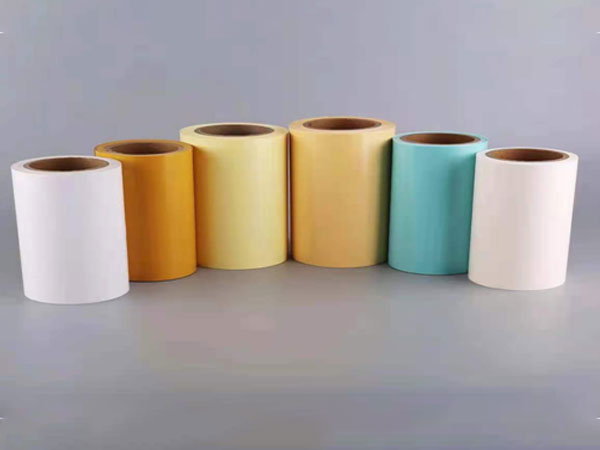Applications and Precautions of Silicone Release Coatings on Glassine Paper

Silicone release coatings are widely used on glassine paper, primarily as backing paper for products such as self-adhesive labels, adhesive tapes, and medical patches. Their primary function is to provide controlled release forces, ensuring seamless peeling of adhesive materials without residue. Below is a detailed overview of applications and precautions:
Double-Sided Silicone Release Paper: Glassine paper coated with silicone release agents on both sides is widely used in applications such as barcode labels, self-adhesive materials, double-sided tapes, trademarks, and laser anti-counterfeiting labels.
High-Speed Labeling: The excellent release performance ensures stable and precise application of labels in high-speed automated labeling systems, thereby enhancing production efficiency.
Medical Products: Serves as release paper for tapes and dressings, meeting stringent hygiene and functionality requirements in the medical sector.
Food and Pharmaceutical Packaging: Utilizes heat resistance, moisture resistance, and oil resistance to maintain packaging stability under high temperatures, extending product shelf life.
The smooth, dense surface of glassine paper enables uniform application of silicone release coatings, resulting in a low-surface-energy layer that is highly resistant to high temperatures (typically exceeding 200℃). This characteristic makes it ideal for high-speed coating and subsequent processing, such as die-cutting and printing.
Release performance, whether light, medium, or high, can be customized by selecting the appropriate silicone release coating type (solvent-based, solventless, or emulsion) and adjusting the curing conditions to meet the requirements of applications such as labels, tapes, or thick adhesive films.
Silicone coatings are resistant to aging and UV exposure, ensuring stable release forces over long-term storage and preventing adhesive migration or silicone transfer.
III. Application Precautions
Glassine Paper Quality: Use a high-density, low-porosity base paper to prevent uneven coating or inconsistent release forces resulting from silicone oil penetration.
Surface Pretreatment: Certain glassine papers necessitate corona treatment or the application of a primer to enhance silicone adhesion.
Coating Method: Roll or blade coating is commonly used; control the coating weight (0.8–1.5 g/m²) to prevent incomplete curing or excessively light release forces.
Process Timeliness: Once the mixed components of the formulation are prepared, they must be used immediately, as their effective bath life does not exceed 12 hours to prevent performance degradation.
Curing Conditions: Precisely control the temperature (120–150°C) and time (10–30 seconds) when using platinum-catalyzed or peroxide-cured silicones to ensure complete curing and prevent under-curing (tackiness) or over-curing (embrittlement). If the curing process is incomplete, it can be remedied by re-curing or reapplying the silicone release coating and then curing it again.
Solvent Quality Control: Trace impurities such as nitrogen (N), phosphorus (P), arsenic (As), lead (Pb), tin (Sn), and moisture can disrupt the curing process. Therefore, it is essential to strictly control the quality of the solvent and maintain cleanliness in containers.
Tool Cleanliness: Ensure that the components of the coating machine, including tanks and rollers, are kept clean to prevent contamination.
Cleanliness: Maintain a dust-free environment to prevent particle adhesion from affecting release performance.
Humidity Control: High humidity can cause glassine paper to absorb moisture and deform, leading to uneven coating and affecting the anti-adhesion effect and curing performance. Strict humidity control is necessary to prevent moisture from compromising the coating quality.
Release Force Testing: Use standardized methods (e.g., FINAT FTM 10) to ensure batch consistency.
Residual Adhesion Rate (RAR): Evaluate silicone transfer risk (target >90%).
Aging Tests: Simulate long-term storage (e.g., 7 days at 40°C, 70% RH) to verify stability.
Store glassine release paper flat or rolled to prevent coating damage from creasing or compression. Avoid high-temperature or humid environments to prevent the degradation of silicone oil.
Silicone Transfer: Use high-crosslink-density silicone oil or modify curing technology.
Uneven Release Force: Inspect coating uniformity or base paper surface defects.
Incomplete Curing: Investigate catalyst activity or oven temperature.
Eco-Friendly Silicone Release Coatings: Increased adoption of solventless (100% solids) and water-based emulsion silicone release coatings.
Functionalized Coatings: Development of specialty release coatings with antistatic and UV-resistant properties for premium applications.
Through stringent control of materials, processes, and environmental factors, silicone release coatings on glassine paper achieve high-performance release effects, meeting the diverse requirements of adhesive products.
Topwin's Siemtcoat® silicone release coating systems consist of four basic components: base polymer, crosslinker, catalyst, and various additives. These components can be combined in numerous ways to create customized formulations, which can be tailored to your needs through consultation with our technical teams.